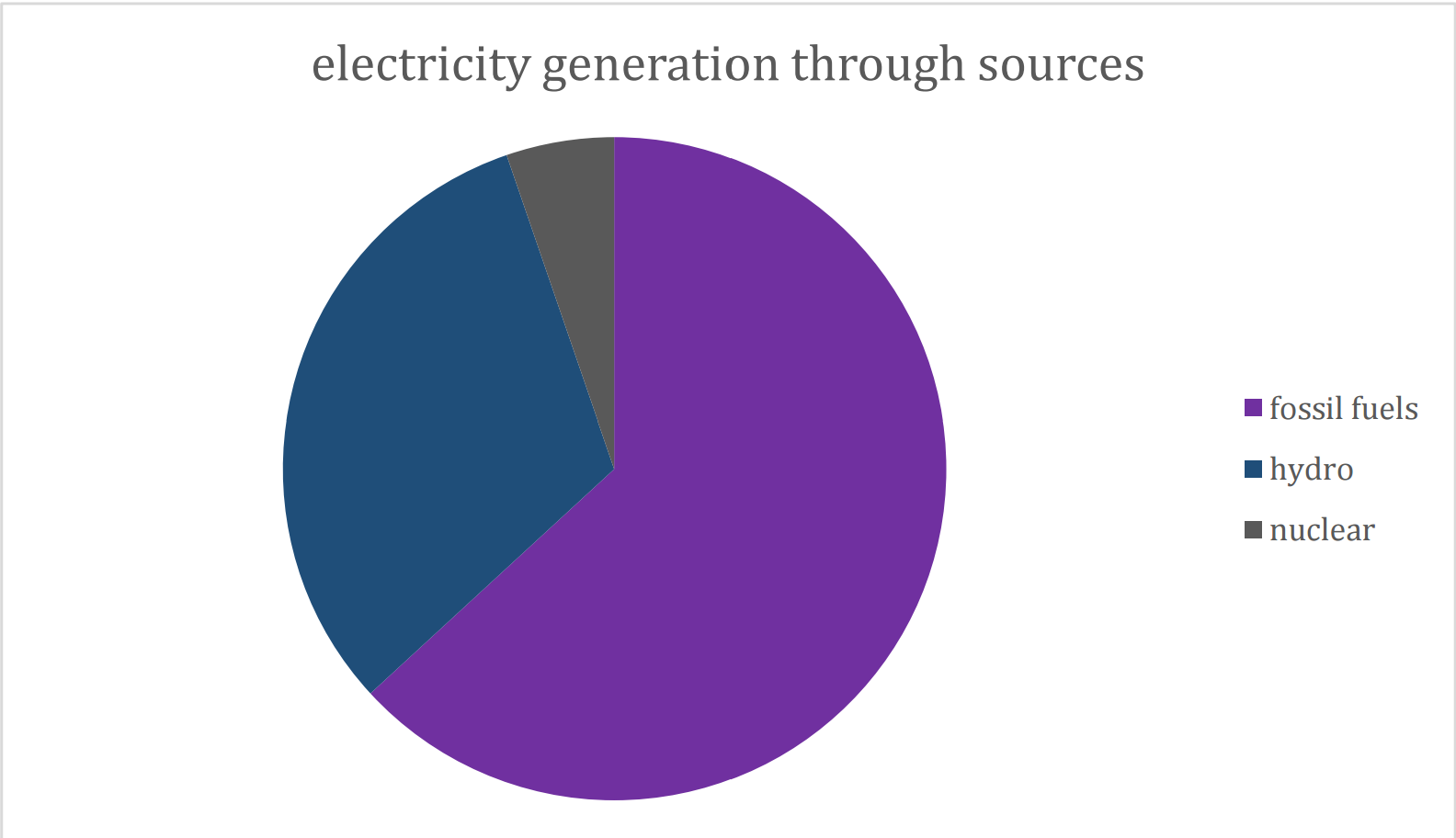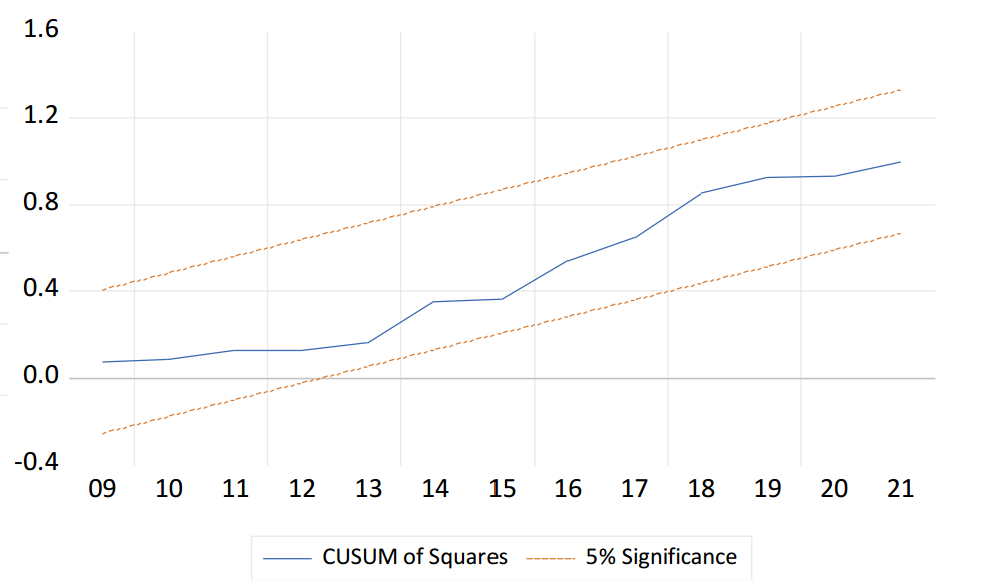Energy, Economy, and Environment Nexus: New Evidence from China
Abstract
At present, global warming poses the greatest threat to the planet's ecosystem. China is the greatest CO2 emitter, expected to account for roughly 33% of overall emissions in 2021, and this has caused authorities to express significant concern in the most latest Paris accord, when they decided to cut global emissions to a particular level. In comparison, 55% of China's power in 2021 appears from coal. As a result, investigating the ecological elements that affect China's CO2 output is essential. This analysis utilizes the autoregressive distributed lag (ARDL) technique to investigate the relationships concerning fossil fuels, renewables, and economic growth from 1990 to 2021. According to the data, using fossil fuels to generate energy and increase GDP significantly increases CO2 emissions. Yet, the use of renewable energy reduces CO2 emissions both in the long run and in the short term. Overall, the outcomes imply that using renewable energy sources is key to reaching sustainable environmental goals and deters the usage of fossil fuels in the energy mix. This study suggests that China take into account empirical findings and undertake long-term initiatives to reduce carbon emissions in favor of sustainable environmental outcomes.
Cite This Paper
Raihan, A. (2023). Energy, Economy, and Environment Nexus: New Evidence from China. Energy Technologies and Environment, 1(1), 4. doi:10.58567/ete01010004
Raihan, A. Energy, Economy, and Environment Nexus: New Evidence from China. Energy Technologies and Environment, 2023, 1, 4. doi:10.58567/ete01010004
Raihan A. Energy, Economy, and Environment Nexus: New Evidence from China. Energy Technologies and Environment; 2023, 1(1):4. doi:10.58567/ete01010004
Raihan, Asif 2023. "Energy, Economy, and Environment Nexus: New Evidence from China" Energy Technologies and Environment 1, no.1:4. doi:10.58567/ete01010004
Show Figures
Share and Cite
Article Metrics
References
- Ali, A. Z., Rahman, M. S., and Raihan, A. (2022). Soil Carbon Sequestration in Agroforestry Systems as a Mitigation Strategy of Climate Change: A Case Study from Dinajpur, Bangladesh. Advances in Environmental and Engineering Research 3(4), 1-15. http://dx.doi.org/10.21926/aeer.2204056.
- Begum, R. A., Raihan, A., and Said, M. N. M. (2020). Dynamic impacts of economic growth and forested area on carbon dioxide emissions in Malaysia. Sustainability 12(22), 9375. https://doi.org/10.3390/su12229375.
- Isfat, M., and Raihan, A. (2022). Current Practices, Challenges, and Future Directions of Climate Change Adaptation in Bangladesh. International Journal of Research Publication and Reviews 3(5), 3429-3437.
- Jaafar, W. S. W. M., Maulud, K. N. A., Kamarulzaman, A. M. M., Raihan, A., Sah, S. M., Ahmad, A., Saad, S. N. M., Azmi, A. T. M., Syukri, N. K. A. J., and Khan, W. R. (2020). The influence of forest degradation on land surface temperature–a case study of Perak and Kedah, Malaysia. Forests 11(6), 670. https://doi.org/10.3390/f11060670.
- Pesaran, M. H., Shin, Y., and Smith, R. J. (2001). Bounds testing approaches to the analysis of level relationships. Journal of applied econometrics 16(3), 289-326. https://doi.org/10.1002/jae.616.
- Raihan, A. (2023a). Nexus between economic growth, natural resources rents, trade globalization, financial development, and carbon emissions toward environmental sustainability in Uruguay. Electronic Journal of Education, Social Economics and Technology 4(2), 55-65. https://doi.org/10.33122/ejeset.v4i2.102.
- Raihan, A. (2023b). An econometric evaluation of the effects of economic growth, energy use, and agricultural value added on carbon dioxide emissions in Vietnam. Asia-Pacific Journal of Regional Science 7(1). https://doi.org/10.1007/s41685-023-00278-7.
- Raihan, A. (2023c). Toward sustainable and green development in Chile: dynamic influences of carbon emission reduction variables. Innovation and Green Development 2, 100038. https://doi.org/10.1016/j.igd.2023.100038.
- Raihan, A. (2023d). The dynamic nexus between economic growth, renewable energy use, urbanization, industrialization, tourism, agricultural productivity, forest area, and carbon dioxide emissions in the Philippines. Energy Nexus 9, 100180. https://doi.org/10.1016/j.nexus.2023.100180.
- Raihan, A., and Said, M. N. M. (2022). Cost–benefit analysis of climate change mitigation measures in the forestry sector of Peninsular Malaysia. Earth Systems and Environment 6(2), 405-419. https://doi.org/10.1007/s41748-021-00241-6.
- Raihan, A., and Tuspekova, A. (2022a). The nexus between economic growth, renewable energy use, agricultural land expansion, and carbon emissions: New insights from Peru. Energy Nexus 6, 100067. https://doi.org/10.1016/j.nexus.2022.100067.
- Raihan, A., and Tuspekova, A. (2022b). Role of economic growth, renewable energy, and technological innovation to achieve environmental sustainability in Kazakhstan. Current Research in Environmental Sustainability 4, 100165. https://doi.org/10.1016/j.crsust.2022.100165.
- Raihan, A., and Tuspekova, A. (2022c). The nexus between economic growth, energy use, urbanization, tourism, and carbon dioxide emissions: New insights from Singapore. Sustainability Analytics and Modeling 2, 100009. https://doi.org/10.1016/j.samod.2022.100009.
- Raihan, A., and Tuspekova, A. (2022d). Dynamic impacts of economic growth, energy use, urbanization, tourism, agricultural value-added, and forested area on carbon dioxide emissions in Brazil. Journal of Environmental Studies and Sciences 12(4), 794-814. https://doi.org/10.1007/s13412-022-00782-w.
- Raihan, A., and Tuspekova, A. (2022e). Dynamic impacts of economic growth, renewable energy use, urbanization, industrialization, tourism, agriculture, and forests on carbon emissions in Turkey. Carbon Research 1(1), 20. https://doi.org/10.1007/s44246-022-00019-z.
- Raihan, A., and Tuspekova, A. (2022f). Towards sustainability: Dynamic nexus between carbon emission and its determining factors in Mexico. Energy Nexus 8, 100148. https://doi.org/10.1016/j.nexus.2022.100148.
- Raihan, A., and Tuspekova, A. (2022g). Nexus between emission reduction factors and anthropogenic carbon emissions in India. Anthropocene Science 1(2), 295-310. https://doi.org/10.1007/s44177-022-00028-y.
- Raihan, A., and Tuspekova, A. (2022h). Toward a sustainable environment: Nexus between economic growth, renewable energy use, forested area, and carbon emissions in Malaysia. Resources, Conservation & Recycling Advances 15, 200096. https://doi.org/10.1016/j.rcradv.2022.200096.
- Raihan, A., and Tuspekova, A. (2022i). Dynamic impacts of economic growth, energy use, urbanization, agricultural productivity, and forested area on carbon emissions: New insights from Kazakhstan. World Development Sustainability 1, 100019. https://doi.org/10.1016/j.wds.2022.100019.
- Raihan, A., and Tuspekova, A. (2022j). Nexus between energy use, industrialization, forest area, and carbon dioxide emissions: New insights from Russia. Journal of Environmental Science and Economics 1(4), 1-11. https://doi.org/10.56556/jescae.v1i4.269.
- Raihan, A., and Tuspekova, A. (2022k). Nexus between economic growth, energy use, agricultural productivity, and carbon dioxide emissions: new evidence from Nepal. Energy Nexus 7, 100113. https://doi.org/10.1016/j.nexus.2022.100113.
- Raihan, A., and Tuspekova, A. (2023a). The role of renewable energy and technological innovations toward achieving Iceland's goal of carbon neutrality by 2040. Journal of Technology Innovations and Energy 2(1), 22-37. https://doi.org/10.56556/jtie.v2i1.421.
- Raihan, A., and Tuspekova, A. (2023b). Towards net zero emissions by 2050: the role of renewable energy, technological innovations, and forests in New Zealand. Journal of Environmental Science and Economics 2(1), 1-16. https://doi.org/10.56556/jescae.v2i1.422.
- Raihan, A., and Voumik, L. C. (2022a). Carbon emission dynamics in India due to financial development, renewable energy utilization, technological innovation, economic growth, and urbanization. Journal of Environmental Science and Economics 1(4), 36-50. https://doi.org/10.56556/jescae.v1i4.412.
- Raihan, A., and Voumik, L. C. (2022b). Carbon emission reduction potential of renewable energy, remittance, and technological innovation: empirical evidence from China. Journal of Technology Innovations and Energy 1(4), 25-36. https://doi.org/10.56556/jtie.v1i4.398.
- Raihan, A., Begum, R. A., and Said, M. N. M. (2021a). A meta-analysis of the economic value of forest carbon stock. Geografia–Malaysian Journal of Society and Space 17(4), 321-338. https://doi.org/10.17576/geo-2021-1704-22.
- Raihan, A., Begum, R. A., Mohd Said, M. N., and Abdullah, S. M. S. (2019). A review of emission reduction potential and cost savings through forest carbon sequestration. Asian Journal of Water, Environment and Pollution 16(3), 1-7. https://doi.org/10.3233/AJW190027.
- Raihan, A., Begum, R. A., Mohd Said, M. N., and Pereira, J. J. (2021b). Assessment of carbon stock in forest biomass and emission reduction potential in Malaysia. Forests 12(10), 1294. https://doi.org/10.3390/f12101294.
- Raihan, A., Begum, R. A., Nizam, M., Said, M., and Pereira, J. J. (2022a). Dynamic impacts of energy use, agricultural land expansion, and deforestation on CO2 emissions in Malaysia. Environmental and Ecological Statistics 29, 477-507. https://doi.org/10.1007/s10651-022-00532-9.
- Raihan, A., Begum, R. A., Said, M. N. M., and Abdullah, S. M. S. (2018). Climate change mitigation options in the forestry sector of Malaysia. J. Kejuruter. 1, 89-98. http://dx.doi.org/10.17576/jkukm-2018-si1(6)-11.
- Raihan, A., Begum, R. A., Said, M. N. M., and Pereira, J. J. (2022b). Relationship between economic growth, renewable energy use, technological innovation, and carbon emission toward achieving Malaysia’s Paris agreement. Environment Systems and Decisions 42, 586-607. https://doi.org/10.1007/s10669-022-09848-0.
- Raihan, A., Farhana, S., Muhtasim, D. A., Hasan, M. A. U., Paul, A., and Faruk, O. (2022c). The nexus between carbon emission, energy use, and health expenditure: empirical evidence from Bangladesh. Carbon Research 1(1), 30. https://doi.org/10.1007/s44246-022-00030-4.
- Raihan, A., Muhtasim, D. A., Farhana, S., Hasan, M. A. U., Paul, A., and Faruk, O. (2022e). Toward environmental sustainability: Nexus between tourism, economic growth, energy use and carbon emissions in Singapore. Global Sustainability Research 1(2), 53–65. https://doi.org/10.56556/gssr.v1i2.408.
- Raihan, A., Muhtasim, D. A., Farhana, S., Hasan, M. A. U., Pavel, M. I., Faruk, O., Rahman, M., and Mahmood, A. (2022d). Nexus between economic growth, energy use, urbanization, agricultural productivity, and carbon dioxide emissions: New insights from Bangladesh. Energy Nexus 8, 100144. https://doi.org/10.1016/j.nexus.2022.100144.
- Raihan, A., Muhtasim, D. A., Farhana, S., Hasan, M. A. U., Pavel, M. I., Faruk, O., Rahman, M., and Mahmood, A. (2023a). An econometric analysis of Greenhouse gas emissions from different agricultural factors in Bangladesh. Energy Nexus 9, 100179. https://doi.org/10.1016/j.nexus.2023.100179.
- Raihan, A., Muhtasim, D. A., Farhana, S., Pavel, M. I., Faruk, O., and Mahmood, A. (2022f). Nexus between carbon emissions, economic growth, renewable energy use, urbanization, industrialization, technological innovation, and forest area towards achieving environmental sustainability in Bangladesh. Energy and Climate Change 3, 100080. https://doi.org/10.1016/j.egycc.2022.100080.
- Raihan, A., Muhtasim, D. A., Farhana, S., Rahman, M., Hasan, M. A. U., Paul, A., and Faruk, O. (2023b). Dynamic linkages between environmental factors and carbon emissions in Thailand. Environmental Processes 10(1), 5. https://doi.org/10.1007/s40710-023-00618-x.
- Raihan, A., Muhtasim, D. A., Khan, M. N. A., Pavel, M. I., and Faruk, O. (2022i). Nexus between carbon emissions, economic growth, renewable energy use, and technological innovation towards achieving environmental sustainability in Bangladesh. Cleaner Energy Systems 3, 100032. https://doi.org/10.1016/j.cles.2022.100032.
- Raihan, A., Muhtasim, D. A., Pavel, M. I., Faruk, O., and Rahman, M. (2022g). An econometric analysis of the potential emission reduction components in Indonesia. Cleaner Production Letters 3, 100008. https://doi.org/10.1016/j.clpl.2022.100008.
- Raihan, A., Muhtasim, D. A., Pavel, M. I., Faruk, O., and Rahman, M. (2022h). Dynamic impacts of economic growth, renewable energy use, urbanization, and tourism on carbon dioxide emissions in Argentina. Environmental Processes 9, 38. https://doi.org/10.1007/s40710-022-00590-y.
- Raihan, A., Pavel, M. I., Muhtasim, D. A., Farhana, S., Faruk, O., and Paul, A. (2023c). The role of renewable energy use, technological innovation, and forest cover toward green development: evidence from Indonesia. Innovation and Green Development 2, 100035. https://doi.org/10.1016/j.igd.2023.100035.
- Voumik, L. C., Islam, M. J., and Raihan, A. (2022a). Electricity production sources and CO2 emission in OECD countries: static and dynamic panel analysis. Global Sustainability Research 1(2), 12-21. https://doi.org/10.56556/gssr.v1i2.327.
- Voumik, L. C., Nafi, S. M., Kuri, B. C., and Raihan, A. (2022b). How tourism affects women's employment in Asian countries: an application of Generalized Method of Moments and Quantile Regression. Journal of Social Sciences and Management Studies 1(4), 57-72. https://doi.org/10.56556/jssms.v1i4.335.
- World Bank. (2023). World Development Indicators (WDI), Data series by The World Bank Group, The World Bank: Washington, DC, USA. Retrieved from https://databank.worldbank.org/source/world-development-indicators.



